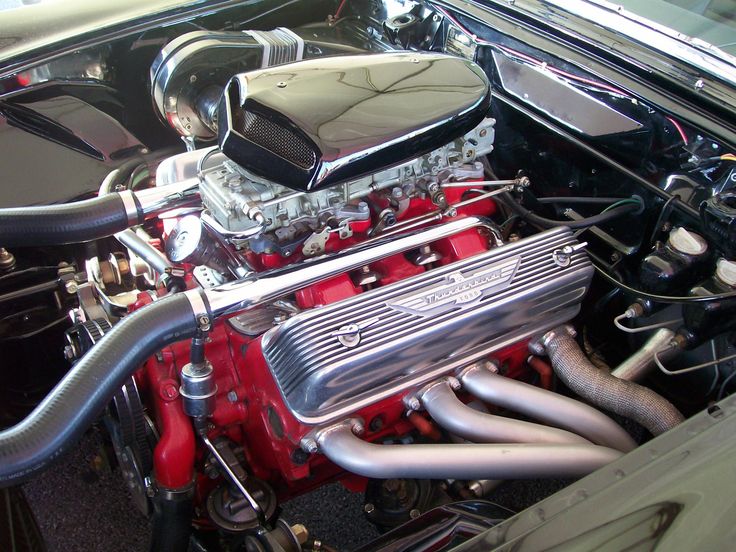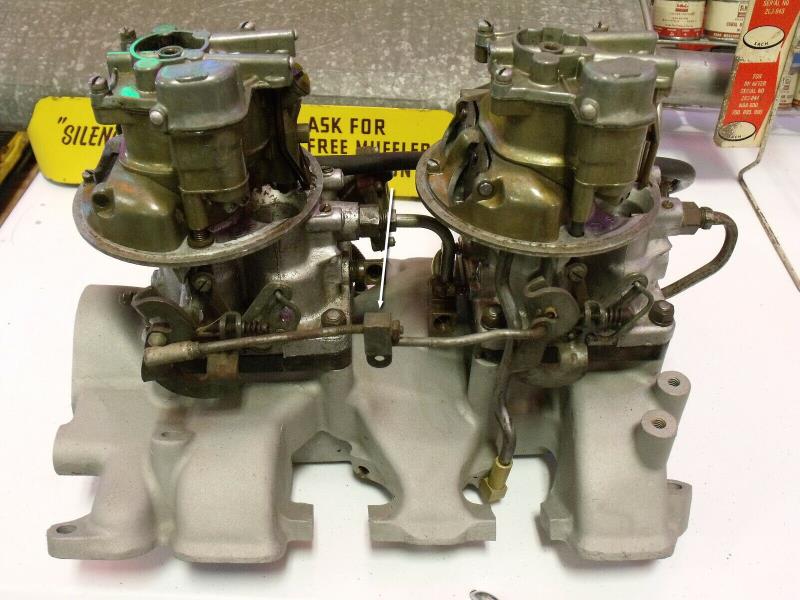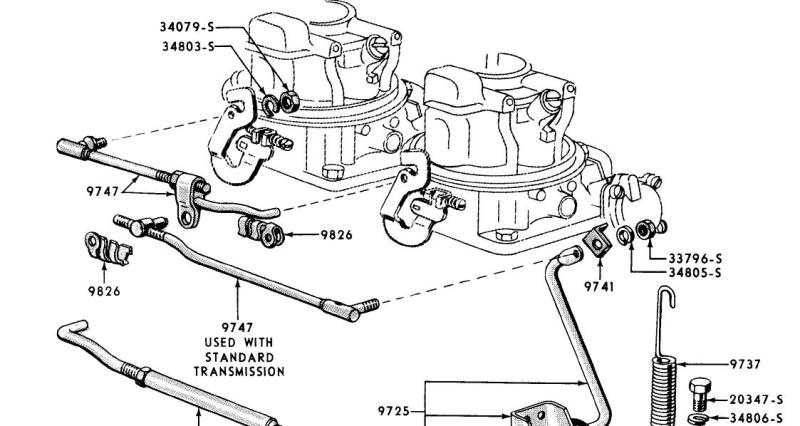|
Author
|
Message
|
|
Ted
|
|
|
Group: Administrators
Last Active: 4 days ago
Posts: 7.5K,
Visits: 205.9K
|
|
|
|
|
|
Florida_Phil
|
|
|
Group: Forum Members
Last Active: 3 Years Ago
Posts: 1.2K,
Visits: 285.6K
|
Got it. My next step is to test mount the dual quad manifold and carbs to check for hood clearance. There is a good possibility I may have to turn the carbs around backward or even mill the choke towers. From what I can tell so far, it looks like the carbs themselves will clear. The air cleaners will be the problem. Here's a photo of the Doane Spensor TBird. He had to modify the hood. I don't know what manifold he was using. 

|
|
|
|
|
KULTULZ
|
|
|
Group: Forum Members
Last Active: Yesterday
Posts: 1.8K,
Visits: 306.3K
|
I'm having a difficult time finding the part in the photo below. Lots of suppliers make a rod with ends to connect both carbs, The Thunderbird linkage requires a hole mid way. There is 8 3/4" between the carb linkage holes. Does anyone reproduce this linkage or must I fabricate it?

The part you show is part on an assembly - B7A 9747-E (ST) - B7A 9747-F (OD). It is for a 57 E-CODE ASSY only as the throttle rods would be too short for your carb spacing.

____________________________
|
|
|
|
|
NoShortcuts
|
|
|
Group: Forum Members
Last Active: 3 Years Ago
Posts: 1.4K,
Visits: 179.6K
|
Ted. THANKS for correcting my earlier entry where I stated that the FE Fords with dual quads had direct throttle linkage rather than progressive throttle linkage. QUESTION for all . . .The Ford y-block production dual quad '56 Power Pack set-ups and the '57 E code dual quad set-ups using direct linkage were prone to Holley 4000 carburetor backfires and sometimes carburetor fires. I speculate the backfires were likely due to poor tune-up OR operator failure to adequately warm-up the engine before 'pushing it'. Carburetor backfires sometimes resulted in damage to or actual melting of the Holley 4000's zinc die cast primary venturi booster cluster with their brass donut rings. Are carburetor backfires and carburetor fires less apt to occur when progressive throttle linkage is used with dual quad carburetor set-ups? Thanks!  NoShortcuts
NoShortcuts
a.k.a. Charlie Brown
near Syracuse, New York
|
|
|
|
|
KULTULZ
|
|
|
Group: Forum Members
Last Active: Yesterday
Posts: 1.8K,
Visits: 306.3K
|
Maybe before worrying about linkage setups, you need to mount the intake and carbs for measuring hood clearance(s) as having to turn the carbs will require linkage modification(s). Measure the carb pad throttle bores and if only 1.5", you will need an adapter(s) that has champfered throttle bore openings to accept the later HOLLEYS. And even if you mill the choke towers, you will need an air cleaner(s). The EDEL intake you have was used for the 1956 MERC M260 option (8V) MGK-66005-AA if you need the reference.
____________________________
|
|
|
|
|
KULTULZ
|
|
|
Group: Forum Members
Last Active: Yesterday
Posts: 1.8K,
Visits: 306.3K
|
QUESTION for all . . .
The Ford y-block production dual quad '56 Power Pack set-ups and the '57 E code dual quad set-ups using direct linkage were prone to Holley 4000 carburetor backfires and sometimes carburetor fires. I speculate the backfires were likely due to poor tune-up OR operator failure to adequately warm-up the engine before 'pushing it'. Carburetor backfires sometimes resulted in damage to or actual melting of the Holley 4000's zinc die cast primary venturi booster cluster with their brass donut rings.
Are carburetor backfires and carburetor fires less apt to occur when progressive throttle linkage is used with dual quad carburetor set-ups?
I think the problem mainly was the design of the H4000 having the fuel bowl over the carb throttle body opening. Either a backfire, fuel leak or improper maintenance could set one off. I see no way style of linkage would have any effect (IMO).
____________________________
|
|
|
|
|
Ted
|
|
|
Group: Administrators
Last Active: 4 days ago
Posts: 7.5K,
Visits: 205.9K
|
Florida_Phil (1/1/2020)
... My next step is to test mount the dual quad manifold and carbs to check for hood clearance. There is a good possibility I may have to turn the carbs around backward or even mill the choke towers. From what I can tell so far, it looks like the carbs themselves will clear. The air cleaners will be the problem. ...Correct me if I’m wrong on this but I’m thinking that the air cleaner placement stays the same on the 4150/4160 carbs regardless if they are facing forward or backwards. The air cleaner pad on the Teapot cars is offset which in effect doubles when reversing the carb direction but the air cleaner pads on the 4150/4160 carbs are centered. If wanting to use the factory progressive linkage from the FE and SBF dual quad setups, then the carbs turned backwards would be the way to go for that. Keep in mind that the model 4160 Holley carbs will have ½” more clearance at the front bowl if turned backwards but that same ½” you save at the front ends up being ½” less between the rear bowl.
  Lorena, Texas (South of Waco) Lorena, Texas (South of Waco)
|
|
|
|
|
NoShortcuts
|
|
|
Group: Forum Members
Last Active: 3 Years Ago
Posts: 1.4K,
Visits: 179.6K
|
KULTULZ (1/1/2020)
QUESTION for all . . .
The Ford y-block production dual quad '56 Power Pack set-ups and the '57 E code dual quad set-ups using direct linkage were prone to Holley 4000 carburetor backfires and sometimes carburetor fires. I speculate the backfires were likely due to poor tune-up OR operator failure to adequately warm-up the engine before 'pushing it'. Carburetor backfires sometimes resulted in damage to or actual melting of the Holley 4000's zinc die cast primary venturi booster cluster with their brass donut rings.
Are carburetor backfires and carburetor fires less apt to occur when progressive throttle linkage is used with dual quad carburetor set-ups?
I think the problem mainly was the design of the H4000 having the fuel bowl over the carb throttle body opening. Either a backfire, fuel leak or improper maintenance could set one off. I see no way style of linkage would have any effect (IMO).
Kultulz. With the direct linkage of the carburetors, two carburetors are keeping the engine running at speed. Either of the two carburetors may be the source of the backfire. IF there is a backfire, the engine will continue to run at speed because the second carburetor will provide the air fuel mixture with it's throttle plates open. My thinking is that with the engine continuing to run at speed, it feeds a fire. Going at my question another way, IF you're running progressive linkage with the dual quads, because the backfire of the single carburetor is not fed by as much air being drawn into the air cleaner by the engine still running at speed with the throttle plates of the second carb being virtually closed, is there less chance of a catastrophic fire?
NoShortcuts
a.k.a. Charlie Brown
near Syracuse, New York
|
|
|
|
|
KULTULZ
|
|
|
Group: Forum Members
Last Active: Yesterday
Posts: 1.8K,
Visits: 306.3K
|
Kultulz. With the direct linkage of the carburetors, two carburetors are keeping the engine running at speed. Either of the two carburetors may be the source of the backfire. IF there is a backfire, the engine will continue to run at speed because the second carburetor will provide the air fuel mixture with it's throttle plates open. My thinking is that with the engine continuing to run at speed, it feeds a fire.
Going at my question another way, IF you're running progressive linkage with the dual quads, because the backfire of the single carburetor is not fed by as much air being drawn into the air cleaner by the engine still running at speed with the throttle plates of the second carb being virtually closed, is there less chance of a catastrophic fire?
I understand what you are saying and keep in mind I am no expert. I am a shade-tree and junkyard dog sort of person.
To me, such an event is caused by either a too lean fuel mixture or gasoline falling out of suspension (cold ambient air operation), poor/weak ignition components such as poor quality wires, defective cap, ign/curving and/or valve timing. On a race engine you want the mixture fat as gasoline is also a coolant and you want to CYA at high RPM. On a street engine, you want a leaner mixture to prevent plug/carbon fouling.
I see your concern with added air ingestion with multi-carb. The problem(s) I see is the H4000 fuel bowl placement. If you have a flash, it is in a stove.
One can use an O2 Sensor with gauge to monitor fuel mixture if you are not rich enough for a chassis dyno and exhaust gas analyzer time.
Hope I made sense ...
____________________________
|
|
|
|
|
KULTULZ
|
|
|
Group: Forum Members
Last Active: Yesterday
Posts: 1.8K,
Visits: 306.3K
|
Knew I would forget something. Many racers run without an air cleaner. Besides ingesting filthy air, there is no flash suppressor. I have read accounts of the 8V H4000 having fires. Maybe this would possibly be a cause?
____________________________
|
|
|
|